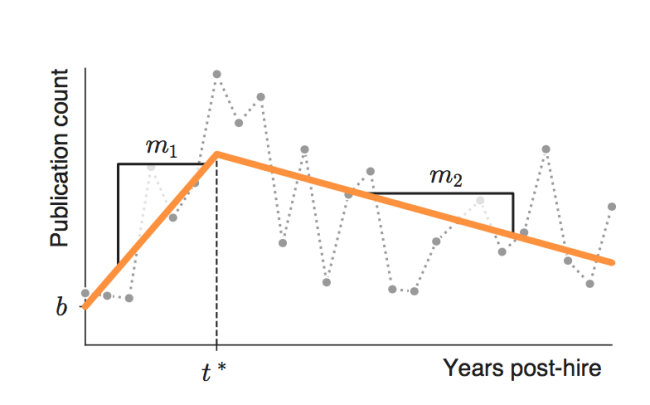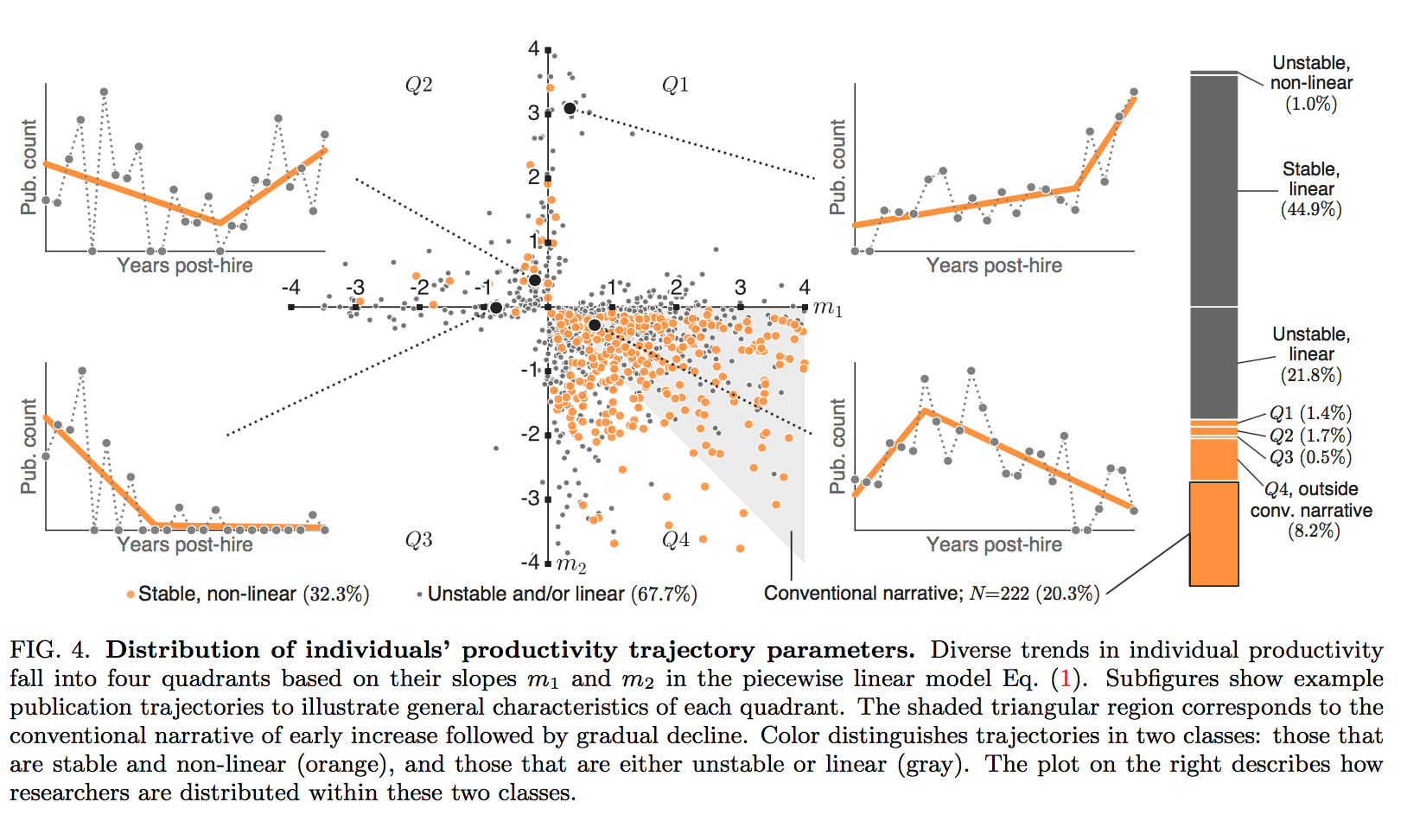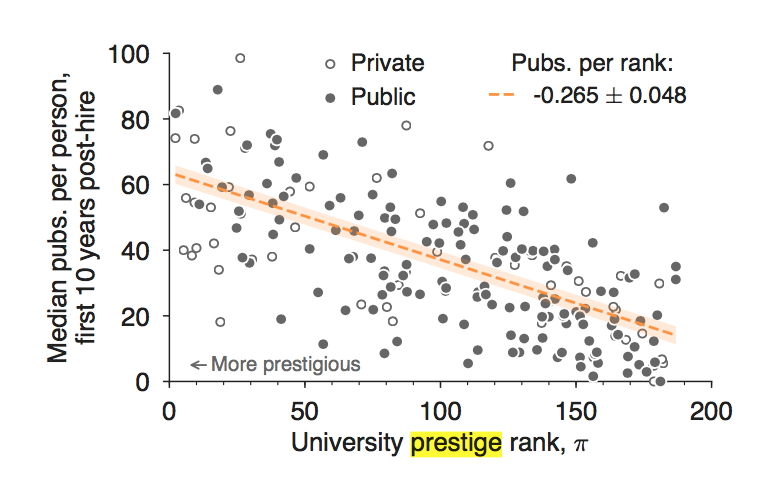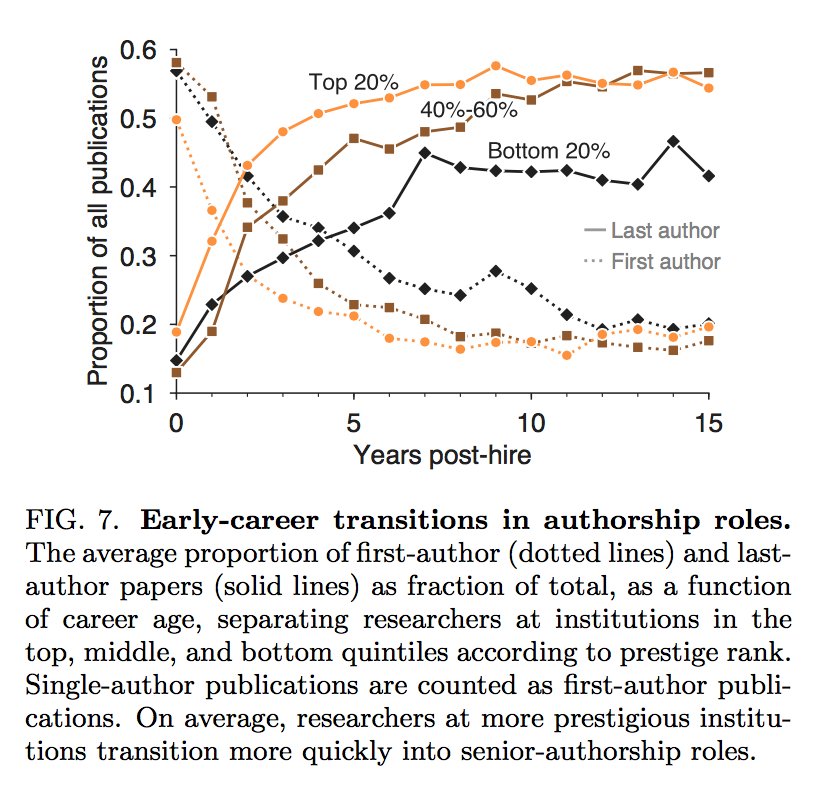You have /5 articles left.
Sign up for a free account or log in.

There's more than meets the eye to the typical faculty productivity curve.
Samuel Way
Conventional wisdom on faculty research productivity, backed by decades of studies, says that it’s all downhill after tenure. A new paper challenges that paradigm, suggesting great variability in peak research activity among individual scientists -- even if their aggregate productivity curve still feeds the posttenure “dead weight” myth.
“Despite the persistent conventional narrative and expectations about productivity, individual people have incredibly diverse careers,” said Samuel Way, a postdoctoral research associate in computer science at the University of Colorado at Boulder and the paper’s lead author. “This is a cautionary tale to administrators and other people in power in the sciences as to why they shouldn’t expect everyone’s career trajectory to look the exact same way.”
The majority of academics who don’t fit the mold “aren't errors, they’re people,” he added.
Way said the finding has implications for hiring and funding decisions and tenure and retirement policies. If only a fraction of academics -- approximately 20 percent in the study -- peak in productivity early in their careers, faculty search committees might do well to look beyond younger, prolific candidates, for example. Institutions, meanwhile, might worry less about older professors delaying retirement.
“The Misleading Narrative of the Canonical Faculty Productivity Trajectory” was published online Tuesday in the Proceedings of the National Academy of Sciences. Way’s co-authors are Boulder computer science colleagues Allison C. Morgan, a Ph.D. candidate, and Aaron Clauset and Daniel B. Larremore, both assistant professors.
While past studies have “firmly established that the conventional academic productivity narrative is equally descriptive across fields and time, their analyses are based on averages over hundreds or thousands of individuals,” reads the paper. “This raises two crucial and previously unanswered questions: Is this average trajectory representative of individual faculty, and how much diversity is hidden by a focus on a central tendency over a population?”
The new analysis is unlike previous ones in its scope and detail, encompassing virtually all tenure-track and tenured professors of computer science in the U.S. and Canada over the last 40 years. To compile their data set, the authors matched 200,000 publications with publicly available hiring information on nearly 2,500 tenure-line faculty members from all 205 computer science Ph.D. programs in the two countries.
While the professors' average productivity curve peaked early and declined slowly over time, resembling those in so many studies before this one, the picture looked very different when the authors mapped individual data against it. Just 20 percent of professors fit the curve, while the other 80 percent were all over the map, staying steady or even peaking late in their careers. That's regardless of their departments' prestige.

Source: Samuel Way
While the most common productivity peak among professors in the sample was five years after hire, just half the senior professors studied reached their peak by that time in their careers.
The authors’ attempt to explain that diversity led them to a second, significant finding: departmental prestige predicts overall individual productivity and the timing of first (lead) author publications to last (senior) author publications. That is, "researchers who graduated from or were hired by top-ranked institutions are significantly more productive at the onset of their careers, and, furthermore, productivity of high-prestige faculty tends to grow at faster rates and achieve higher peaks than researchers employed by other institutions."
Researchers' productivity grew by a median of about two additional papers per year while working at elite institutions (the top 20 percent of programs) compared with the rest of their peers. Researchers who earned doctorates from elite institutions also exhibited faster early-career growth than their peers from lower-ranked programs.

Way said that scientists from top Ph.D. programs likely have access to resources that have allowed them to set up labs and execute research agendas with relative speed. One potential area for future study, he said, is what policies enable such early-career research success, and whether they can be replicated at less prestigious institutions.

Similar to others, Way’s study notes that scientists now publish about four times more papers per year than they did in 1970; that was established as a control early in the study to more accurately study professors working then and now as part of the same sample. About half the papers in the study were published by about 20 percent of the professors in the sample.
Women were also found to publish significantly less than men early in their careers, to the tune of about 0.5 fewer publications, regardless of where they trained or were hired; the authors suggest this discrepancy is an area for future study.
Way’s isn’t the first study to push back on the prevailing view on productivity. A 2016 paper published in Science, for example, argued that scientific impact, at least, is randomly distributed within the sequence of papers published by a scientist -- so it’s not age dependent.
Bruce Weinberg, a professor of economics at Ohio State University, co-wrote another paper published in PNAS earlier this year on the aging scientific work force; he found that the average age of employed scientists in the U.S. increased from 45 in 1993 to nearly 49 in 2010. While the study had potentially negative implications for the job market for younger scientists, Weinberg said at the time that older scientists doesn't mean less innovative science, and he called the prevailing wisdom on that front “at best an oversimplification and maybe wrong.”
The new study is, therefore, broadly consistent with Weinberg’s research, he said Tuesday. “There are many people who are more creative later in their careers, and the tendency to do the most or best work early in the career is actually less common today than it had been in the past.”
Weinberg said he's found that people whose work is more empirical or experimental tend to do their best work later in their careers, while people whose work is more “conceptual or theoretical or abstract tend to do their best work earlier in their careers.” As knowledge accumulates over time, he added, “it takes longer for people to get to the knowledge frontier, and people tend to do their best work later in their lives.”
That said, Weinberg noted that Way’s emphasis on computer science is particularly interesting because the field often emphasizes abstract conceptual reasoning, which would seem to lead to earlier peaks.
As to how the findings might inform institutional policies, tenure decisions and resource allocation, Weinberg said it’s important to recognize systematic individual variations “because not everyone is going to follow the archetypical pattern.”
While Way’s paper focuses on computer science professors, he said there’s no reason to think his findings won’t apply to other fields, even those outside the sciences. Indeed, he and his colleagues are interested in applying their analysis to other disciplines going forward.
Cassidy Sugimoto, an associate professor of informatics at Indiana University at Bloomington, co-wrote a paper finding that professors in sociology, economics and political science (on average) remain highly productive across the span of the career. While productivity increases steeply until promotion to associate professor, her paper says, it remains stable thereafter. Collaboration, meanwhile, increases with age.
That eventual stabilization isn’t necessarily a bad thing, Sugimoto said Tuesday, since “one could question whether the drive for hyperproductivity in the pretenure era produces the highest-quality research.” It would be useful, therefore, to see Way’s data matched to citation counts, she said.
Sugimoto said she did question whether the posttenure "dead weight" argument has become something of a straw man. First-time recipients of major grants from the National Institutes of Health are 42 years old, on average, she said, and resources are strongly concentrated around senior researchers.
“In an increasingly collaborative age, scholars benefit by the size of their labs, which is associated with more senior scholars,” she said. “The tenure model certainly promotes high productivity in early years, but I have seen no strong data that demonstrates a general posttenure decline. Most of the conversation tends to revolve around isolated anecdotes.”





